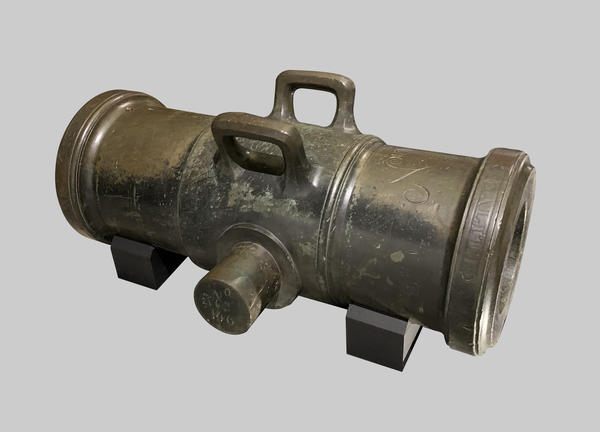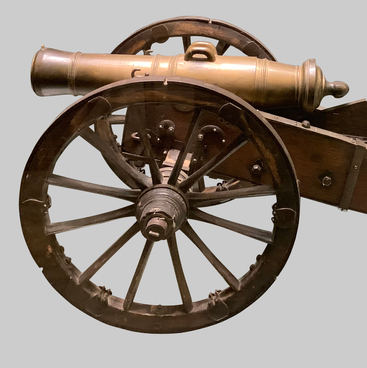The artillery’s composition of Napoleon’s Grande Armée was rather complex. It was shaped by the experience gained in past wars, augmented by the knowledge and expertise available at the time. Naturally, not least important were materials at the disposal of manufacturers. By 1812, France had emerged to dominate the world, thus organizational principles of the French military were influenced by the armies in satellite nations.
In the run-up to the war against the Russian Empire Napoleon, having captured almost entire Europe, possessed scores of spoils of war, including artillery systems of various types and calibers. He faced an arduous task of repairing and fielding them all, let alone providing each piece with ammunition. Not the easiest thing to do, this took much of Napoleon’s time.
When the war against Russia went in full swing, Napoleon’s artillery had two types of cannons, namely howitzers and guns. Made from bronze, both were smoothbore, muzzle-loading weapons. The Russian military also had licornes, apart from these two.
The guns fired solid iron balls and case shots along a flat trajectory. Like artillery shells used by the Russian troops, case shots were tin glasses containing iron bullets arranged in a specific order. Naturally, the French case shot adopted in the wake of the 1805-1807 wars shaped that later used in Russian guns.
Another type of weapons, bronze howitzers mounted on carriages, had curved trajectories to attack targets from above. Like guns, howitzers were loaded with case shots, as well as grenades, iron balls stuffed with powder.
12-ft guns and 6.4-in howitzers belonged to artillery companies in the corps reserve. 6-in and 5.6-in howitzers were delivered to companies of infantry and heavy cavalry divisions. 3-ft guns, which used to belong to the Austrian and Prussian militaries before Napoleon’s victories in Europe, comprised regimental artillery. Each regiment of the Grande Armée received 2-4 pieces to provide fire support in combat.
As of 1812, Napoleon’s forces numbered 1,372 artillery pieces in good repair, of which less than a half had been manufactured in France. Almost all of them, originated in France, Germany, Austria, Saxony, Italy, Naples, Bavaria, Holland, Württemberg, etc., were abandoned by the French on the battlefields in the Russian Empire.
The exhibit is a trophy captured in the War of the Fourth Coalition (1806-1807). After combat the weapon was moved to the Riga Armory and then turned over to St. Petersburg’s Memorable Hall. Then the French 6.4-in ended up in the exposition of the Artillery Museum.
In the run-up to the war against the Russian Empire Napoleon, having captured almost entire Europe, possessed scores of spoils of war, including artillery systems of various types and calibers. He faced an arduous task of repairing and fielding them all, let alone providing each piece with ammunition. Not the easiest thing to do, this took much of Napoleon’s time.
When the war against Russia went in full swing, Napoleon’s artillery had two types of cannons, namely howitzers and guns. Made from bronze, both were smoothbore, muzzle-loading weapons. The Russian military also had licornes, apart from these two.
The guns fired solid iron balls and case shots along a flat trajectory. Like artillery shells used by the Russian troops, case shots were tin glasses containing iron bullets arranged in a specific order. Naturally, the French case shot adopted in the wake of the 1805-1807 wars shaped that later used in Russian guns.
Another type of weapons, bronze howitzers mounted on carriages, had curved trajectories to attack targets from above. Like guns, howitzers were loaded with case shots, as well as grenades, iron balls stuffed with powder.
12-ft guns and 6.4-in howitzers belonged to artillery companies in the corps reserve. 6-in and 5.6-in howitzers were delivered to companies of infantry and heavy cavalry divisions. 3-ft guns, which used to belong to the Austrian and Prussian militaries before Napoleon’s victories in Europe, comprised regimental artillery. Each regiment of the Grande Armée received 2-4 pieces to provide fire support in combat.
As of 1812, Napoleon’s forces numbered 1,372 artillery pieces in good repair, of which less than a half had been manufactured in France. Almost all of them, originated in France, Germany, Austria, Saxony, Italy, Naples, Bavaria, Holland, Württemberg, etc., were abandoned by the French on the battlefields in the Russian Empire.
The exhibit is a trophy captured in the War of the Fourth Coalition (1806-1807). After combat the weapon was moved to the Riga Armory and then turned over to St. Petersburg’s Memorable Hall. Then the French 6.4-in ended up in the exposition of the Artillery Museum.



